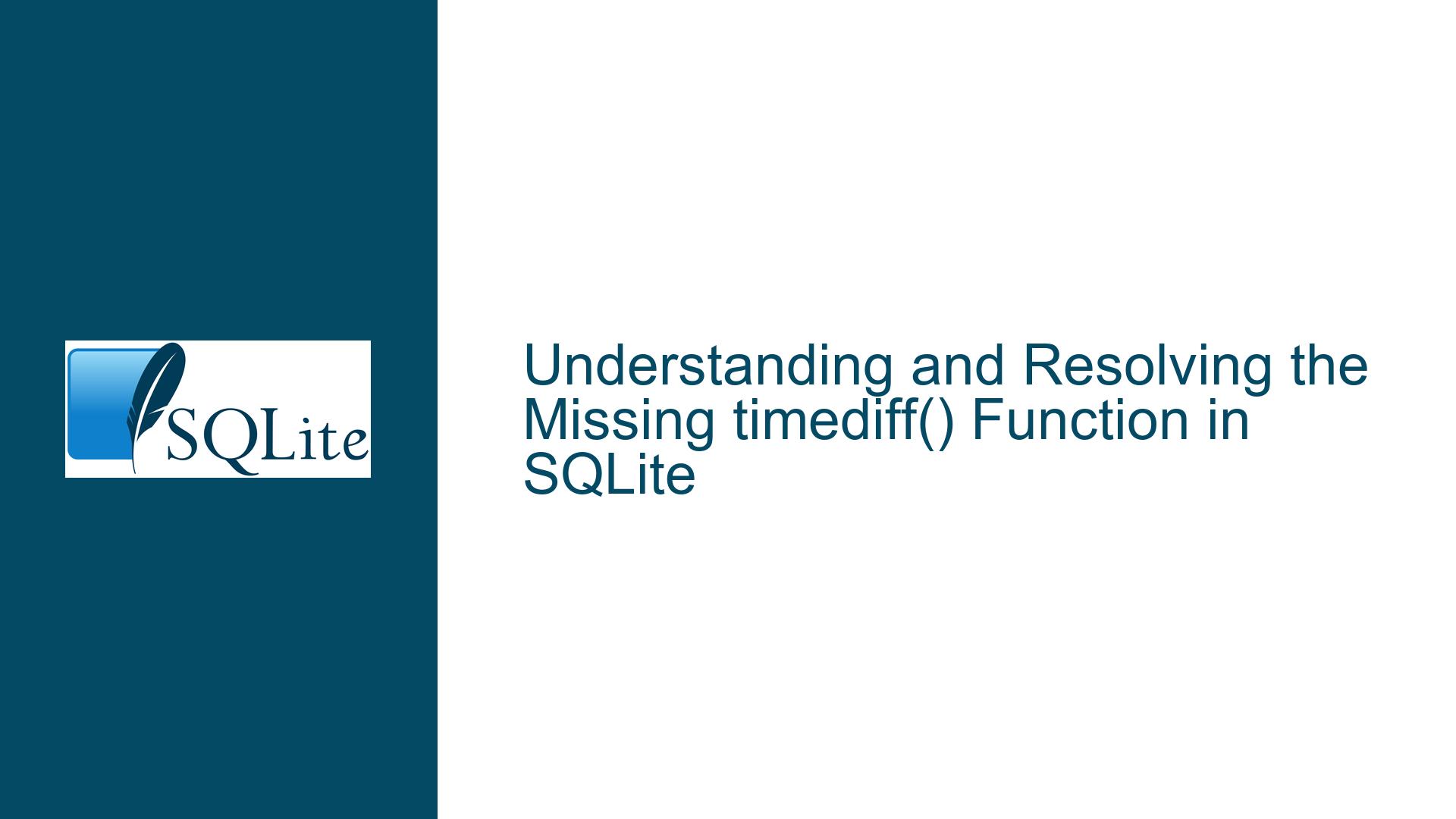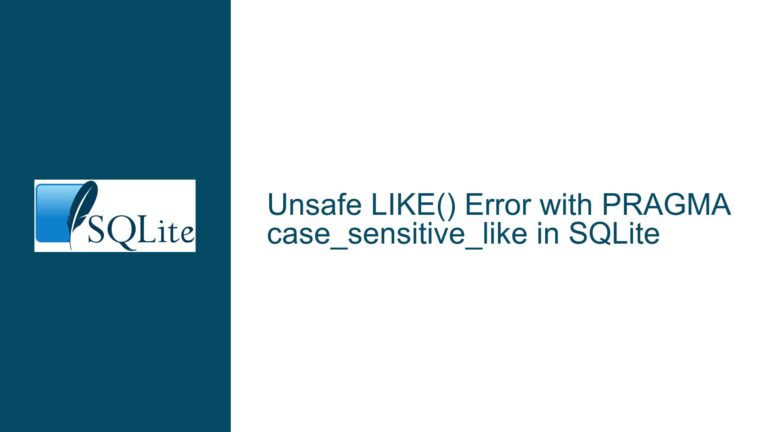and Resolving the Missing timediff() Function in SQLite
Issue Overview: The Absence of timediff() in Older SQLite Versions
The core issue revolves around the absence of the timediff() function in SQLite, which is a relatively new addition to the SQLite library. The timediff() function is designed to calculate the difference between two datetime values, returning the result as a time interval. This function is particularly useful for applications that require precise time calculations, such as scheduling systems, time tracking applications, or any system that relies on temporal data manipulation.
The problem arises when users attempt to use the timediff() function in environments where the SQLite version is older than 3.43.0, which was released on August 24, 2023. In such cases, executing a query that includes timediff() results in an error message indicating that the function does not exist. This error is not due to a syntax issue or a misconfiguration but is directly related to the version of SQLite being used.
The confusion often stems from the fact that timediff() is documented as a built-in function in the SQLite documentation, leading users to assume that it should be available in all versions. However, the documentation does not always clearly indicate which functions are available in which versions, especially for recently added features. This can lead to frustration, particularly for developers who are working with older versions of SQLite or who are using tools that bundle an older version of SQLite, such as SQLiteStudio 3.4.4.
Possible Causes: Version Mismatch and Tooling Constraints
The primary cause of the issue is a version mismatch between the SQLite library and the tools or frameworks that interact with it. SQLite is a lightweight, serverless database engine that is often embedded within applications or used in conjunction with various development tools. These tools, such as SQLiteStudio or Microsoft.EntityFrameworkCore.Sqlite, may bundle a specific version of SQLite, which may not be the latest one.
In the case of SQLiteStudio 3.4.4, the bundled version of SQLite predates the release of SQLite 3.43.0, which introduced the timediff() function. This means that any attempt to use timediff() within SQLiteStudio 3.4.4 will fail, as the function is not available in the bundled SQLite version. Similarly, Microsoft.EntityFrameworkCore.Sqlite 7.0.12, released on October 10, 2023, may not yet be synchronized with the latest SQLite version, potentially leading to the same issue.
Another contributing factor is the lack of awareness among developers about the version-specific nature of certain SQLite functions. While SQLite is known for its backward compatibility, new functions like timediff() are only available in the versions where they were introduced. Developers who are not familiar with the release history of SQLite may inadvertently use functions that are not available in their environment, leading to errors.
Troubleshooting Steps, Solutions & Fixes: Ensuring Compatibility and Exploring Alternatives
To resolve the issue of the missing timediff() function, developers need to take a systematic approach that involves verifying the SQLite version, updating tools and libraries, and exploring alternative methods for calculating time differences.
Step 1: Verify the SQLite Version
The first step is to determine the version of SQLite that is being used in the environment where the timediff() function is failing. This can be done by executing the following SQL query:
SELECT sqlite_version();
This query will return the version of SQLite that is currently in use. If the version is older than 3.43.0, the timediff() function will not be available. In such cases, the next step is to update the SQLite version to at least 3.43.0.
Step 2: Update SQLite and Related Tools
If the SQLite version is outdated, the next step is to update it to a version that includes the timediff() function. This may involve updating the SQLite library itself, as well as any tools or frameworks that bundle SQLite.
For example, if SQLiteStudio 3.4.4 is being used, it may be necessary to upgrade to a newer version of SQLiteStudio that bundles a more recent version of SQLite. Similarly, if Microsoft.EntityFrameworkCore.Sqlite is being used, it may be necessary to check for updates or wait for a future release that includes support for SQLite 3.43.0 or later.
Step 3: Explore Alternative Methods for Calculating Time Differences
If updating the SQLite version or related tools is not feasible, developers can explore alternative methods for calculating time differences. SQLite provides several built-in functions that can be used to manipulate and compare datetime values, even without the timediff() function.
One common approach is to use the julianday() function, which converts a datetime value into a Julian day number. The difference between two Julian day numbers can then be calculated to determine the time interval between two datetime values. For example:
SELECT (julianday('2023-03-15') - julianday('2023-02-15')) * 86400 AS timediff_seconds;
In this example, the julianday() function is used to convert the datetime values ‘2023-03-15’ and ‘2023-02-15’ into Julian day numbers. The difference between these numbers is then multiplied by 86400 (the number of seconds in a day) to obtain the time difference in seconds.
Another approach is to use the strftime() function to extract specific components of a datetime value, such as the number of days, hours, minutes, or seconds. These components can then be used to calculate the time difference manually. For example:
SELECT
(strftime('%s', '2023-03-15') - strftime('%s', '2023-02-15')) AS timediff_seconds;
In this example, the strftime() function is used to extract the number of seconds since the Unix epoch for each datetime value. The difference between these values is then calculated to obtain the time difference in seconds.
Step 4: Implement Custom Functions (Optional)
For developers who require more advanced time calculations or who prefer a more reusable solution, it is possible to implement custom SQLite functions using the SQLite C API or a programming language that supports SQLite extensions, such as Python or C#. These custom functions can replicate the behavior of timediff() or provide additional functionality that is not available in the built-in SQLite functions.
For example, in Python, the sqlite3 module allows developers to create custom SQLite functions using the create_function() method. A custom timediff() function could be implemented as follows:
import sqlite3
from datetime import datetime
def timediff(dt1, dt2):
fmt = '%Y-%m-%d %H:%M:%S'
t1 = datetime.strptime(dt1, fmt)
t2 = datetime.strptime(dt2, fmt)
return (t2 - t1).total_seconds()
conn = sqlite3.connect('example.db')
conn.create_function('timediff', 2, timediff)
cursor = conn.cursor()
cursor.execute("SELECT timediff('2023-03-15 00:00:00', '2023-02-15 00:00:00')")
result = cursor.fetchone()
print(result) # Output: (2419200.0,)
In this example, a custom timediff() function is implemented in Python and registered with the SQLite connection. This function can then be used in SQL queries just like a built-in function.
Step 5: Plan for Future Compatibility
Finally, developers should plan for future compatibility by staying informed about new SQLite releases and the features they introduce. This includes regularly checking the SQLite changelog, subscribing to relevant mailing lists or forums, and testing new versions of SQLite in a controlled environment before deploying them to production.
By following these steps, developers can effectively address the issue of the missing timediff() function in SQLite, ensuring that their applications remain functional and compatible with the latest SQLite features.






